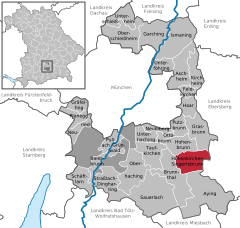Höhenkirchen-Siegertsbrunn
Municipality in Bavaria, Germany From Wikipedia, the free encyclopedia
Höhenkirchen-Siegertsbrunn is a municipality in Upper Bavaria, situated south of Munich. It is one of the municipalities with the longest names in Germany, the longest being Hellschen-Heringsand-Unterschaar.
Höhenkirchen-Siegertsbrunn | |
|---|---|
 Church of Saint Leonard | |
Location of Höhenkirchen-Siegertsbrunn within Munich district  | |
| Coordinates: 48°01′N 11°44′E | |
| Country | Germany |
| State | Bavaria |
| Admin. region | Oberbayern |
| District | Munich |
| Subdivisions | 3 Ortsteile |
| Government | |
| • Mayor (2020–26) | Mindy Konwitschny[1] (SPD) |
| Area | |
| • Total | 15.19 km2 (5.86 sq mi) |
| Elevation | 586 m (1,923 ft) |
| Population (2023-12-31)[2] | |
| • Total | 11,417 |
| • Density | 750/km2 (1,900/sq mi) |
| Time zone | UTC+01:00 (CET) |
| • Summer (DST) | UTC+02:00 (CEST) |
| Postal codes | 85635 |
| Dialling codes | 08102 |
| Vehicle registration | M |
| Website | www.hoehenkirchen-siegertsbrunn.de |
Geography
Höhenkirchen-Siegertsbrunn lies 20 kilometers south-east of Munich.
History
Höhenkirchen-Siegertsbrunn is a combination of two villages that were once independent, as can be seen on old maps. (see: BayernAtlas) Höhenkirchen and Siegertsbrunn were first mentioned in 1020 and 1048 respectively. Höhenkirchen was known as Marchwartsbrunn until around the 12th century, named after its founders Marchwart and Sigoho. The two names ending in -brunn (which means well in German) have to do with the deep wells, up to 30 metres deep, that were dug to make it possible for people to live there.[3]
With the arrival of a railway connection in 1904, industry and commerce in Höhenkirchen grew rapidly until the 1960s. The population continued to grow after 1945 due to the expulsion of Germans to other European countries after the Second World War.[3]
The two villages were amalgamated into their present form in 1978.[3]
Transport
In 1972, the Höhenkirchen-Siegertsbrunn station was erected, connecting the two villages to the Munich-Giesing–Kreuzstraße line of the Munich S-Bahn.[3]
Politics
The municipality has a council of 24 people plus the mayor. The deputy mayor (or vice-mayor) is also a member of the council. The council usually meets once a month. Municipal elections in Bavaria are held every six years, with the current term running until from 2020 to 2026.[4]
The current mayor is Mindy Konwitschny of the SPD and her deputy is Luitgart Dittmann-Chylla of the Green Party.[4]
International relations
Twin towns — Sister cities
Höhenkirchen-Siegertsbrunn is twinned with:

 Montemarciano, Italy since 2005
Montemarciano, Italy since 2005
 Chéroy, France since 14 May 1967
Chéroy, France since 14 May 1967
A sign mentioning the twinnings is visible when entering the village.[5]
Literature
- "Chronik eines Dorfes" by Rudolf Stingl
- "Heimatbuch von Siegertsbrunn" by Wolfgang Bethke.
References
Wikiwand in your browser!
Seamless Wikipedia browsing. On steroids.
Every time you click a link to Wikipedia, Wiktionary or Wikiquote in your browser's search results, it will show the modern Wikiwand interface.
Wikiwand extension is a five stars, simple, with minimum permission required to keep your browsing private, safe and transparent.



